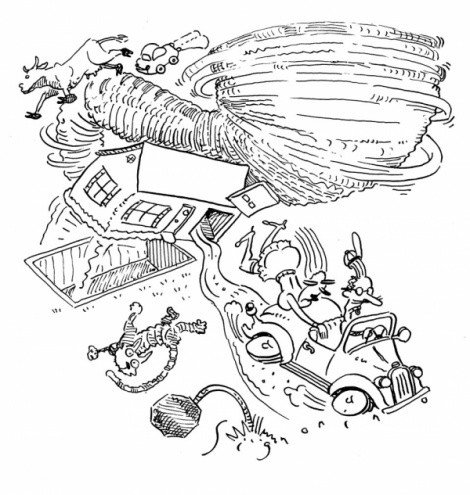
Just how safe is it to shelter in your basement during a tornado? When I was growing up in the Midwest, I was given the impression that the basement was a pretty safe place to be if a tornado hit your house. But surely there must be cases of people being crushed by debris or sucked out and thrown into the air while they are hiding in their basement. When we read about fatalities from a tornado, how many of these people were sheltering in their basements, thinking they were safe? —Mark Pietrzyk
Some people—perhaps a dwindling number—don’t think the recent wild weather has anything to do with climate change. Maybe it doesn’t. Just the same, I’d pay attention to the following. Might be some news you could use.
So far this year, we’ve had at least 537 tornado fatalities in the United States, a huge increase over the 45 deaths in 2010, and the most since 1936. The reason for this alarming leap, undoubtedly, is the large number of tornadoes this season, although there has also been a noticeable increase in the percentage of especially destructive tornadoes.
To start with the obvious, one place you don’t want to wait out a tornado is in a mobile home. This year, trailers have accounted for nearly one in four fatalities, and a ten-year review of 18,717 tornado deaths found that 44 percent happened in mobile homes.
The safest place to be is in a reinforced concrete building, but if that’s not an option, a basement really is your best bet. An analysis of the Oklahoma tornado outbreak of May 1999, which featured an EF5 (i.e., scale-topping monster) twister, found that out of 40 deaths, 133 severe injuries and 265 minor injuries, the total harm inflicted on people holed up in basements amounted to just one minor injury. In the Joplin, Mo., area—where the death toll stands at a staggering 155 following the tornado of May 22—82 percent of homes had no basements.
What’s the safest corner of the basement? A common belief is that since most tornadoes in the United States travel from west-southwest to east-northeast, the southwest side of the basement is the safest place to hide out.
The originator of this advice may be John Park Finley, one of the first serious meteorological researchers, who studied hundreds of tornadoes in a career spanning the late 19th and early 20th centuries. Finley said you should never take refuge in the east side of a basement and specifically warned against the northeast corner—he reasoned that debris from the house would be blown in that direction.
Unfortunately, he was wrong, especially where brick or stone houses are concerned. In 1966, Joe Eagleman of the University of Kansas studied the wreckage of the EF5 Topeka tornado of that year and concluded that if you had a full basement, the northeast corner was the safest place to be and the south side the most dangerous. Why? External debris knocked down southern walls and blew in through south-facing basement windows; when winds shifted the whole house to the northeast, the southwest corner of the basement was where the upper stories fell in.
Can basements be dangerous regardless? Absolutely. In April, an Iowa couple took cover in an all-concrete “tornado room” they’d built in their basement only to have the wind rip away the eight-inch-thick slab that served as its ceiling. Their pickup truck was then flung into the basement, flattening their pool table but leaving the remains of the bunker (and them) unharmed.
No basement? Running for it won’t do you much good, but driving for it might. A study of the May 1999 Oklahoma City tornado concluded that those who fled in vehicles were much less likely to be injured than those who stayed put. No vehicle either? A review of the “core remnants” of houses hit by EF3 tornadoes found the safest places were an interior bathroom or closet. Another study of that Oklahoma City tornado found that, safety-wise, interior hallways were a distant second to basements.
Looking ahead, a backyard storm cellar like Auntie Em’s is starting to sound like a good investment. If you’d like your house to survive, too, you can take some relatively simple precautions. Homes typically come apart in high winds because the roof gets blown off and the exterior walls collapse inward. Using steel hurricane straps to anchor your roof to the house is cheap and easy, and other steel reinforcements can be used to strengthen the walls.
Flimsy garage doors are another common source of house failure—the wind blows them in, and then blasts through the house and rips the walls and ceiling apart. A 1982 review found that in 104 cases of home roof damage after a tornado in Grand Island, Neb., nearly 50 percent started via the garage. Steel or reinforced garage doors are the solution.
Give it some thought. Times are changing. One wants to be prepared.
Send questions to Cecil via StraightDope.com or write him c/o Chicago Reader, 11 E. Illinois, Chicago 60611. Subscribe to the Straight Dope podcast at the iTunes Store.